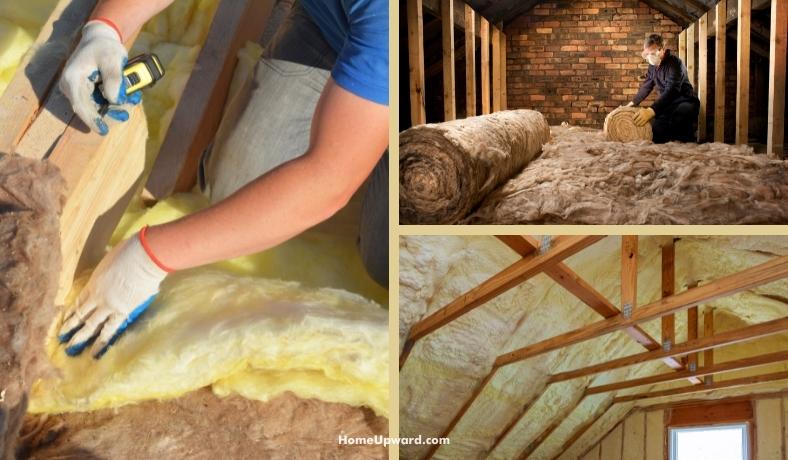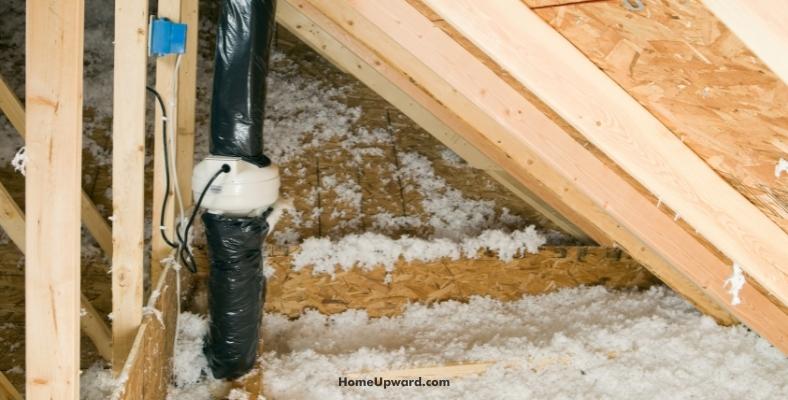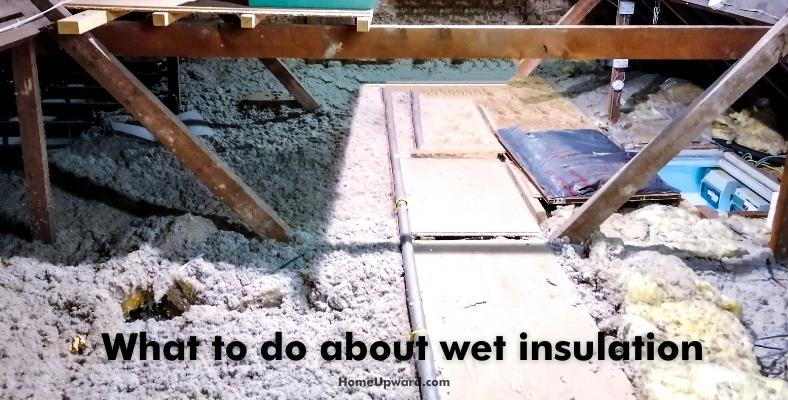Contents
What Happens to Attic Insulation After it Gets Wet?
A few things will happen when insulation gets wet. The biggest problems you may face are mold growth and the insulation losing its insulation value.
Both of these are causes for insulation removal and some time and money.
Wet Insulation Can Lose Its Insulation Value
Fiberglass insulation and cellulose insulation can both absorb a lot of water. When this happens, the insulation loses its insulation value, also known as its R-Value.
Wet cellulose insulation becomes more compacted which can take away from its R-Value by up to 40%!
Fiberglass itself doesn’t actually absorb water but the fiberglass batt allows room for it to be held. Fiberglass that is wet or saturated with water can’t insulate against heat as it usually would.
In both cases you’ll suffer energy efficiency problems as the performance will take a hit.
Mold Growth Can Be a Problem
Moisture and heat in a dark area are the most common cause of mold growth. When moist air gets into an attic, which is often warmer than the rest of the house, mold grows. This also applies to moisture in the insulation.
Fiberglass traps mold inside itself which allows it to grow on the paper backing the matting is attached to. Cellulose insulation gets a chemical treatment that disallows mold growth but can still transfer mold by absorbing water with mold spores.
Mold growth isn’t an issue just for insulation. If mold grows in your insulation, it can grow elsewhere in your attic too. A wet attic causes mold issues across the board.
What to Do About Wet Insulation
It is easy to panic when facing a costly job like an insulation replacement. The good news is that you may be able to salvage the situation and save on the cost of replacing your insulation.
If your insulation isn’t compacted, moldy, or otherwise damaged, you can probably skip replacement and dry it yourself.
How Do You Dry Out Your Attic?
It’s essential to dry out your attic insulation as quickly as possible if it has become moist due to leaks or humidity. Since mold and mildew can begin to grow in as little as 24 hours, quick action needs to be taken.
- The best way to dry out wet attic insulation is to remove it and lay it out in the sun to dry. If you have a lot of insulation you may need to rent a dumpster to dispose of it. Once the insulation is dry you can replace it with new insulation.
- Another option for drying out wet attic insulation is to use a floor fan. Place the fan in your attic space and point it at the wet insulation. The airflow from the fan will help speed up the drying process but you’ll need decent ventilation so the moisture can escape, drying them out as it does.
- If you have a dehumidifier you can place it in your attic to help remove excess moisture from the air and dry out wet insulation. Just be sure to empty the dehumidifier regularly so it doesn’t overflow (you can also run a drainage hose elsewhere on some models of dehumidifiers.)
If you have exposed fiberglass insulation and you’re using a fan, make sure the fan isn’t kicking up fiberglass dust.
Once you’ve got the moisture under control and dried out or on its way to being dried out, be sure to identify the source of the water and humidity. There are a lot of possible causes of attic moisture and can be anything from a roof leak or a burst pipe to moisture from your bathroom not being vented outside.
When Should Wet Attic Insulation be Removed and Replaced?
Whether wet attic insulation needs to be removed and replaced depends on the water damage caused by the moisture problem.
If the insulation is just a little damp and not too much time has elapsed, you might still be able to save it by completely drying it off. However, it’s usually advisable to replace the insulation if it is excessively damp or has been wet for a long time.
Mold or mildew growth are definite signs it needs to be removed and replaced.
Keep in mind that attic insulation doesn’t last forever. Even if it doesn’t get wet it’ll eventually settle and lose effectiveness. For this reason, it’s a good rule of thumb to check your attic insulation regularly and replace it every 10-15 years anyhow.
How Does Mold Grow on Insulation?
Yes, mold can grow on insulation and typically grows on the paper-like material backing the matting is attached to. Anywhere you have a warm, damp attic, mold spores will find their way into your insulation and walls and can begin growing.
How Do I Know If I Have Mold in My Insulation?
Fiberglass and cellulose insulation are the most likely insulation types to grow mold from attic moisture. Spray foam insulation is very mold-resistant.
- When looking at your insulation, you may notice white, black, gray, or green spots. While these can be dirt, you should always check for mold when you see this discoloration that somewhat resembles mold growth on old food.
- A musty smell is another giveaway if you don’t see any visible mold with your eyes.
Don’t forget to inspect your crawl space insulation. Your crawl space might be a space you don’t think of often. Its insulation is just as susceptible to mold growth and moisture as the rest of the attic.
Can You Live With Mold in Your Attic?
Short-term, yes. Long-term, no. You should not live with it short-term, either, because several health issues can come from living with mold.
Living with mold typically causes health issues that seem to have no cause. Some examples include:
- Coughing
- Wheezing
- Shortness of breath
- Itchy eyes
- Runny nose
In extreme cases, mold spores can cause respiratory problems, headaches, and worse. A few species of black mold can even be toxic and potentially lead to death if enough exposure happens.
Start looking for solutions the moment you find mold. If you can, relocate while you get the mold cleaning taken care of.
How to Keep Your Insulation Dry
Preemptive measures are the best way to keep your insulation dry.
- Good ventilation and working exhaust fans work well, with good ventilation being the first thing you should work on. An attic with no ventilation is as bad as a poorly ventilated bathroom for example.
- If your attic is more prone to moisture a dehumidifier can also help although that’s more of a way to deal with the symptoms of moisture and not the source. Also, they require draining the water tank by hand or by connecting a drain tube to an outside opening.




